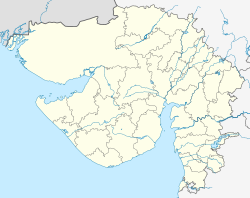Khambhat
|
Khambhat ખંભાત Cambay खंभात |
|
|---|---|
| City | |

Shivling, Ralaj, Khambhat
|
|
| Nickname(s): Trambavati Nagari | |
| Coordinates: 22°18′N 72°37′E / 22.3°N 72.62°ECoordinates: 22°18′N 72°37′E / 22.3°N 72.62°E | |
| Country | India |
| State | Gujarat |
| District | Anand |
| Government | |
| • Type | Nagar Palika |
| Area | |
| • Total | 2,932.9 km2 (1,132.4 sq mi) |
| Population (2011) | |
| • Total | 99,164 (M+OG) |
| • Density | 620/km2 (1,600/sq mi) |
| Languages | |
| • Official | Gujarati |
| Time zone | IST (UTC+5:30) |
| PIN | 388620,388625,388630,388540 |
| Telephone code | 02698 |
| Vehicle registration | GJ 23 |
| Website | www.khambhatnagarpalika.in |
Khambhat (Gujarati: ખંભાત, Hindi: खंभात(![]() pronunciation ), also known as Cambay, is a town and the surrounding urban agglomeration in Khambhat Taluka, Anand district in the Indian state of Gujarat. It was once an important trading center, but its harbour gradually silted up, and the maritime trade moved elsewhere. Khambhat lies on an alluvial plain at the north end of the Gulf of Khambhat, noted for the extreme rise and fall of its tides, which can vary as much as thirty feet in the vicinity of Khambhat. Khambhat is known for its halvasan, sutarfeni and kites (patang). And though being a part of sources of oil and gas.
pronunciation ), also known as Cambay, is a town and the surrounding urban agglomeration in Khambhat Taluka, Anand district in the Indian state of Gujarat. It was once an important trading center, but its harbour gradually silted up, and the maritime trade moved elsewhere. Khambhat lies on an alluvial plain at the north end of the Gulf of Khambhat, noted for the extreme rise and fall of its tides, which can vary as much as thirty feet in the vicinity of Khambhat. Khambhat is known for its halvasan, sutarfeni and kites (patang). And though being a part of sources of oil and gas.
Khambat is perhaps the only place in India, where the Harappan craft – the agate bead making is found in the living tradition. Surprisingly Khambat has no stone deposit. But the craft has survived mainly through acquiring stones from the Rajpipla hills, about 200 km away from the town. In the folklore of Khambat the beginning of the craft is attributed to Baba Ghor, a 1500 AD saint from Ethiopia who had led a large contingent of Muslims to settle in the town. However, in the archaeological record the origin of the craft can be traced to the nearby Lothal, a Harappan outpost flourished about 4000 years ago.
Cambay was formerly a flourishing city, the seat of an extensive trade, and celebrated for its manufactures of silk, chintz and gold stuffs. The Arab traveler al-Mas'udi visited the city in 915 AD, describing it as a very successful port; it was mentioned in 1293 by Marco Polo, who, calling it Cambaet, noted it as a busy port. He mentions that the city had its own king. Indigo and fine buckram were particular products of the region, but much cotton and leather was exported through Cambay. A contemporary Italian traveler, Marino Sanudo, said that Cambeth was one of India’s main two ocean ports. Another Italian, visiting in about 1440, Niccolò de' Conti, mentions that the walls of the city were twelve miles in circumference. The Kothi gateway believed to be constructed by the English factory is in fact a 14th century gate, probably dating to 1330s, of Tughluq era.
...
Wikipedia

